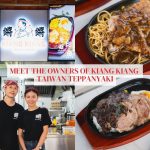Lai Wah: Creator of Lo-Hei!

What better time to talk about yu sheng than during the Chinese New Year season! But this is no ordinary yu sheng, this is the original yu sheng that was first introduced to Singapore at Chinese New Year in 1964. Up till then, Yu Sheng had been a dish eaten during Chinese New Year, but it wasn’t until the “Four Heavenly Kings”* came up with the idea of premixing the sauces and introducing “Lo Hei” or tossing of the salad as a group activity that gave birth to what we know today as yu sheng.
Yu sheng is something Singaporeans should be proud of as it is a piece of culture we are exporting to the world. It ranks up there with the Singapore Sling and chilli crabs as something that is uniquely Singapore. Don’t you think it’s a pity we have to wait eight months just to eat it?
I must admit that I was a little apprehensive before I tried the yu sheng at Lai Wah. If this is the birthplace of yu sheng, what would I write if the yu sheng was not up to par? Thankfully, Lai Wah’s yu sheng truly lived up to its reputation, in comparison to the standard of regular yu sheng. Lai Wah’s yu sheng had the perfect balance of sweet, savoury, tangy, crunchy, chewy and spicy flavours.
The yam ring here was good too. The yam was nice and “sang” (powdery) and the ring crisp. However, I found that there was not enough sauce in the filling. I think it is still worth ordering but I didn’t find it as mouth-watering as their yu sheng.
Yu Lan chicken is a classic poached chicken served with ham and kailan (Chinese vegetable), hence the name Yu Lan, (“Yu” means green jade and “Lan” refers to kailan). I haven’t eaten this dish in a long while, so it was a real blast from the past.

Although Lai Wah prides itself on serving traditional Cantonese cuisine, they have dishes that are designed for the younger generation. One such dish is the fried crispy prawns which all the makan kakis around the table were unanimous in giving it a double “thumbs-up”. The prawns were coated with poh piah skin (springroll skin) and although the flavours were very basic, the prawn was an absolute delight!
Now, when it comes to fish, the Teochews and the Cantonese have differing views on how it should be done. The red garoupa in “two styles” is a dish that has to be ordered in advance because one side of the fish is used to make a delicate wrap while the other is deep fried. As a Teochew Ah Hia (true blue Teochew), I would have preferred my red garoupa steamed with ginger and sour plums. But this dish was fast disappearing the moment it hit the table so I rest my case!
The restaurant is still run by a delightful elderly couple. Their son turns up when the place is packed with customers. Their chef has been working at the restaurant since the time the yu sheng was created. Even though the place was renovated a year and a half ago, it still exudes that “homey” and nostalgic ambience which is very inviting.
As a foodie, I think that Lai Wah deserves some recognition like an award from the Singapore Tourism Board for its contribution to our local cuisine. Such acknowledgement would help to preserve our local food for generations of Singaporeans to come.
*The Four Heavenly Kings here refer to four Chefs namely: Sin Leong, Hooi Kok Wai, the late Tham Mui Kai, and Lau Yoke Pui




